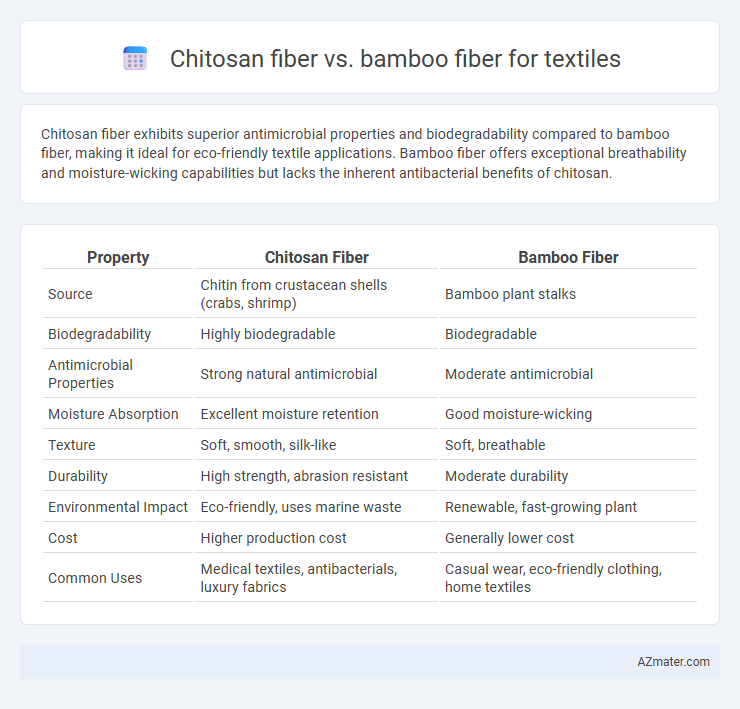Chitosan fiber exhibits superior antimicrobial properties and biodegradability compared to bamboo fiber, making it ideal for eco-friendly textile applications. Bamboo fiber offers exceptional breathability and moisture-wicking capabilities but lacks the inherent antibacterial benefits of chitosan.
Table of Comparison
| Property | Chitosan Fiber | Bamboo Fiber |
|---|---|---|
| Source | Chitin from crustacean shells (crabs, shrimp) | Bamboo plant stalks |
| Biodegradability | Highly biodegradable | Biodegradable |
| Antimicrobial Properties | Strong natural antimicrobial | Moderate antimicrobial |
| Moisture Absorption | Excellent moisture retention | Good moisture-wicking |
| Texture | Soft, smooth, silk-like | Soft, breathable |
| Durability | High strength, abrasion resistant | Moderate durability |
| Environmental Impact | Eco-friendly, uses marine waste | Renewable, fast-growing plant |
| Cost | Higher production cost | Generally lower cost |
| Common Uses | Medical textiles, antibacterials, luxury fabrics | Casual wear, eco-friendly clothing, home textiles |
Introduction to Chitosan Fiber and Bamboo Fiber
Chitosan fiber, derived from chitin found in crustacean shells, offers excellent biodegradability and antimicrobial properties ideal for sustainable textile applications. Bamboo fiber, obtained from bamboo pulp, is known for its natural softness, breathability, and moisture-wicking capabilities, making it popular in eco-friendly clothing. Both fibers contribute to the development of environmentally conscious textiles but differ in their biological origins and functional benefits.
Source and Production Process Comparison
Chitosan fiber is derived from chitin, primarily sourced from crustacean shells such as shrimp and crab, undergoing chemical deacetylation to convert chitin into chitosan before spinning into fibers. Bamboo fiber originates from bamboo pulp, extracted either mechanically through crushing and retting or chemically via viscose or lyocell processes to produce regenerated cellulose fibers. The production of chitosan fiber involves biopolymer extraction and modification, emphasizing biodegradability and antimicrobial properties, while bamboo fiber production focuses on sustainable cellulose extraction with varying environmental impacts depending on the processing method used.
Physical and Mechanical Properties
Chitosan fiber exhibits superior tensile strength and antibacterial properties compared to bamboo fiber, making it more durable and hygienic for textile applications. Bamboo fiber tends to have higher moisture absorption and softness, offering enhanced comfort but reduced mechanical resilience. The physical robustness of chitosan fiber supports longer garment lifespan, while bamboo fiber excels in breathability and eco-friendly biodegradability.
Biodegradability and Environmental Impact
Chitosan fiber exhibits superior biodegradability due to its natural polysaccharide composition derived from crustacean shells, breaking down efficiently in soil and aquatic environments without leaving toxic residues. Bamboo fiber, while also biodegradable and sourced from a rapidly renewable plant, often undergoes chemical-intensive processing that can reduce its eco-friendliness and increase environmental impact. The production of chitosan fiber typically involves less harmful chemicals and utilizes waste materials, positioning it as a more sustainable textile option with a lower carbon footprint compared to bamboo fiber.
Moisture Absorption and Breathability
Chitosan fiber exhibits superior moisture absorption due to its natural hygroscopic properties, making it highly effective in wicking sweat and maintaining skin dryness. Bamboo fiber also offers excellent breathability and moisture management, attributed to its porous structure that facilitates air circulation. Both fibers enhance comfort in textiles, but chitosan's antimicrobial benefits provide an additional advantage in moisture control.
Antimicrobial and Hypoallergenic Characteristics
Chitosan fiber exhibits strong antimicrobial properties due to its natural ability to inhibit bacterial growth, making it highly effective in reducing odor and skin irritation in textiles. Bamboo fiber also offers antimicrobial benefits, attributed to its natural bio-agent called "bamboo kun," but its efficacy tends to be lower than that of chitosan fibers. Both fibers are hypoallergenic; however, chitosan's biocompatibility and moisture-wicking capabilities give it a slight advantage in preventing allergic reactions and maintaining skin comfort.
Dyeability and Color Fastness
Chitosan fiber exhibits superior dyeability due to its amino groups, which enhance dye uptake and result in vibrant, rich colors compared to bamboo fiber. Bamboo fiber's dye affinity is moderate, often requiring chemical treatment to improve color depth and uniformity. Chitosan fiber also demonstrates excellent color fastness to washing and light, outperforming bamboo fiber in retaining color intensity over time.
Textile Applications and Versatility
Chitosan fiber exhibits strong antimicrobial properties and excellent moisture absorption, making it ideal for medical textiles, sportswear, and hygiene products. Bamboo fiber offers softness, breathability, and natural antibacterial qualities, suitable for casual wear, bedding, and eco-friendly fashion. Both fibers enhance fabric comfort and durability, but chitosan's bioactive features provide added functional benefits in specialized textile applications.
Cost Efficiency and Market Availability
Chitosan fiber offers antimicrobial properties and biodegradability but remains costlier due to limited production scale and specialized extraction processes. Bamboo fiber is more widely available and economically efficient, benefiting from established processing techniques and large-scale cultivation. Market demand favors bamboo for affordability and accessibility, while chitosan targets niche, high-value textile sectors focusing on functional performance.
Future Prospects in Sustainable Textiles
Chitosan fiber offers exceptional antimicrobial properties and biodegradability, positioning it as a promising material for sustainable textile innovations. Bamboo fiber is valued for its natural breathability, rapid renewability, and minimal pesticide use, making it a green alternative in eco-friendly fabric production. Future prospects in sustainable textiles emphasize blending chitosan and bamboo fibers to enhance durability, comfort, and environmental benefits, driving circular economy goals in fashion industries.

Infographic: Chitosan fiber vs Bamboo fiber for Textile
 azmater.com
azmater.com